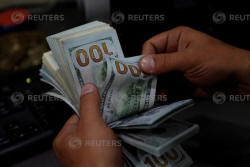Dollar builds toward six-week high as U.S. jobs data
eyed
 Send a link to a friend
Send a link to a friend
 [October 05, 2018]
By Tom Finn [October 05, 2018]
By Tom Finn
LONDON (Reuters) - The dollar edged toward
a six-week high on Friday before monthly U.S. jobs data that investors
hope will shed light on how much longer the Fed's aggressive rate-hiking
cycle will continue.
The U.S. currency is outperforming other major currencies as the U.S.
economy continues to grow strongly while recent data in other large
economies, including the euro zone, has come in below expectations.
Investors are watching for signs of increasing U.S. inflation as
companies including Amazon <AMZN.O> raise minimum wages. Friday's
non-farm payrolls release for September will give new indications of
wage growth and labor market strength.
The dollar index <.DXY>, which measures its performance against a basket
of six currencies, was 0.1 percent higher on the day at 95.907, closing
in on a six-week high of 96.121.

Private payrolls data came in stronger than forecast on Thursday,
pushing the yield on the benchmark 10-year U.S. Treasury note
<US10YT=RR> to its highest levels since May 2011.
"We have downplayed the relevance of the U.S. labor market report for
the dollar ... but the data might become more significant again now
there is debate over how much longer the [Fed] rate hike cycle will
continue," said Antje Praefcke, a currency strategist at Commerzbank in
Frankfurt.
The U.S. central bank foresees another interest rate hike in December,
three more next year, and one in 2020.
Fed Chairman Jerome Powell on Wednesday talked up the U.S. economy,
saying that the United States is on the verge of a "historically rare"
era of ultra-low unemployment and tame prices.
That spooked investors and caused U.S. Treasury yields and the
euro/dollar currency pair to breach key technical levels.
But even if the job's data beats expectations the dollar might not move
significantly because the bar for an upward surprise has been raised by
recent strong data, analysts at MUFG said.
[to top of second column] |

A money changer counts U.S. dollar banknotes at a currency exchange
office in Izmir, Turkey August 16, 2018. REUTERS/Osman Orsal

"Powell has commented that this level of wage growth is not necessarily a sign
of an overheating labor market signaling the Fed remains comfortable with
gradual rate hikes," the analysts said.
AUSSIE FALLS TO MULTI-YEAR LOW
The Australian dollar <AUD=D4>, often viewed as a barometer of risk appetite,
slipped 0.3 percent to $0.7054, a 32-month low, as U.S. yield spreads continued
to widen, pressuring stock markets and risk appetite around the world.
The Aussie, extending losses into a fourth straight session, has now fallen 2.1
percent this month.
The euro <EUR=EBS> edged down 0.1 percent to $1.1497 after brushing a six-week
low of $1.1463 during Thursday's session.
The dollar will continue to strengthen against the euro as well as the yen, with
the common currency likely slipping back below the psychologically significant
$1.15 handle, said Yukio Ishizuki, senior currency strategist at Daiwa
Securities.
The euro is down about 0.8 percent against the dollar this month.
Sterling rose to a three-month high versus the euro on Friday after the European
Union's Brexit negotiators said that a divorce deal with Britain was "very
close".

The pound rose to 88.11 pence <EURGBP=D3>, its highest since July 9, after the
report, which cited two diplomatic sources.
(Additional reporting by Daniel Leussink in Tokyo; editing by Larry King)
[© 2018 Thomson Reuters. All rights
reserved.] Copyright 2018 Reuters. All rights reserved. This material may not be published,
broadcast, rewritten or redistributed.
Thompson Reuters is solely responsible for this content. |